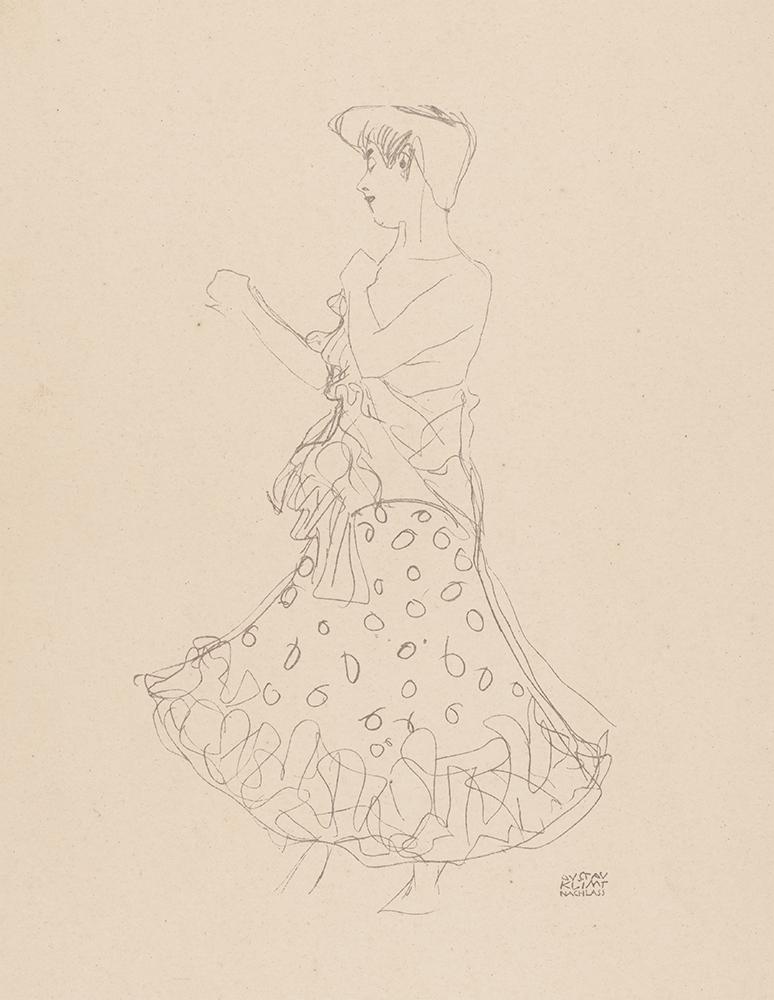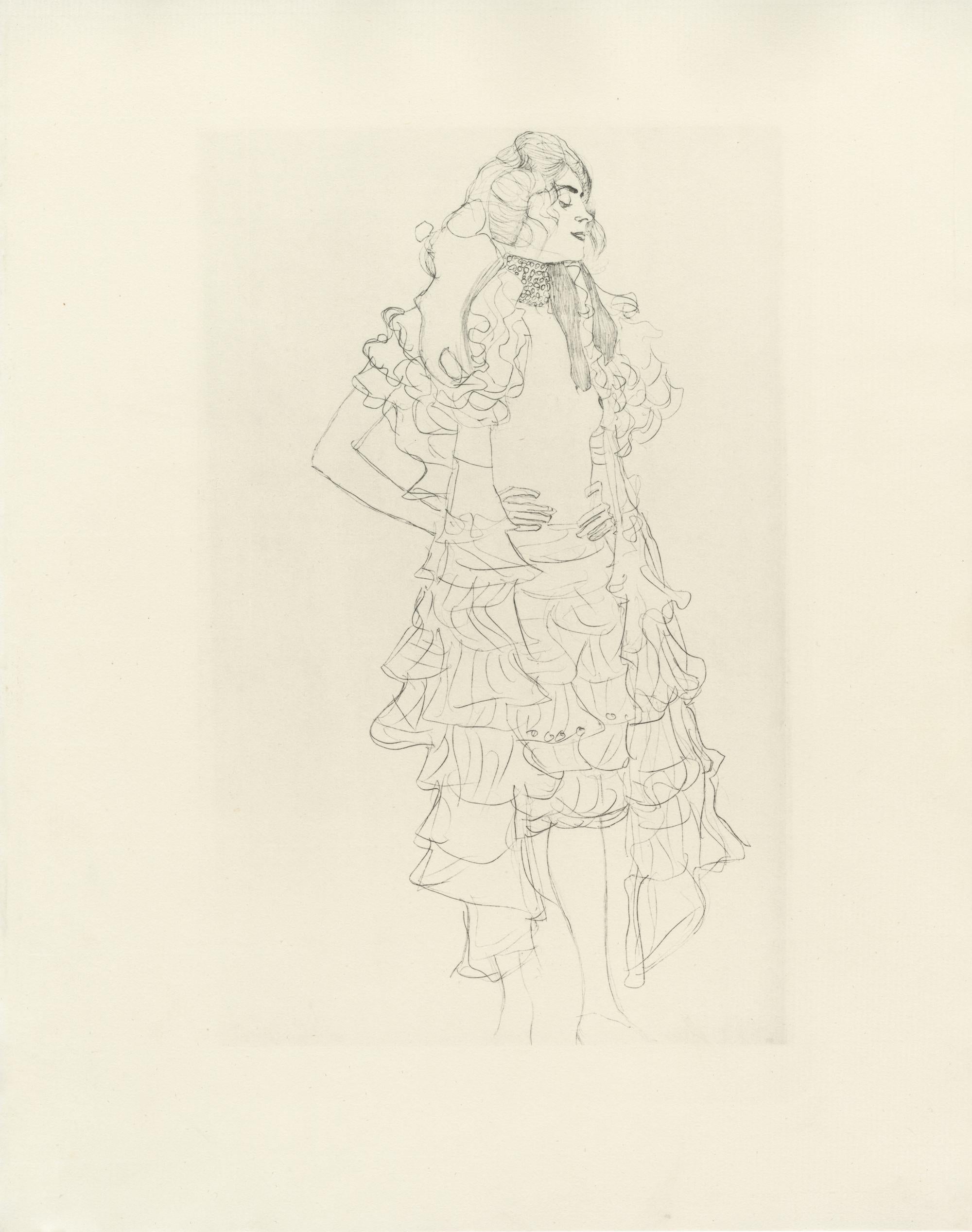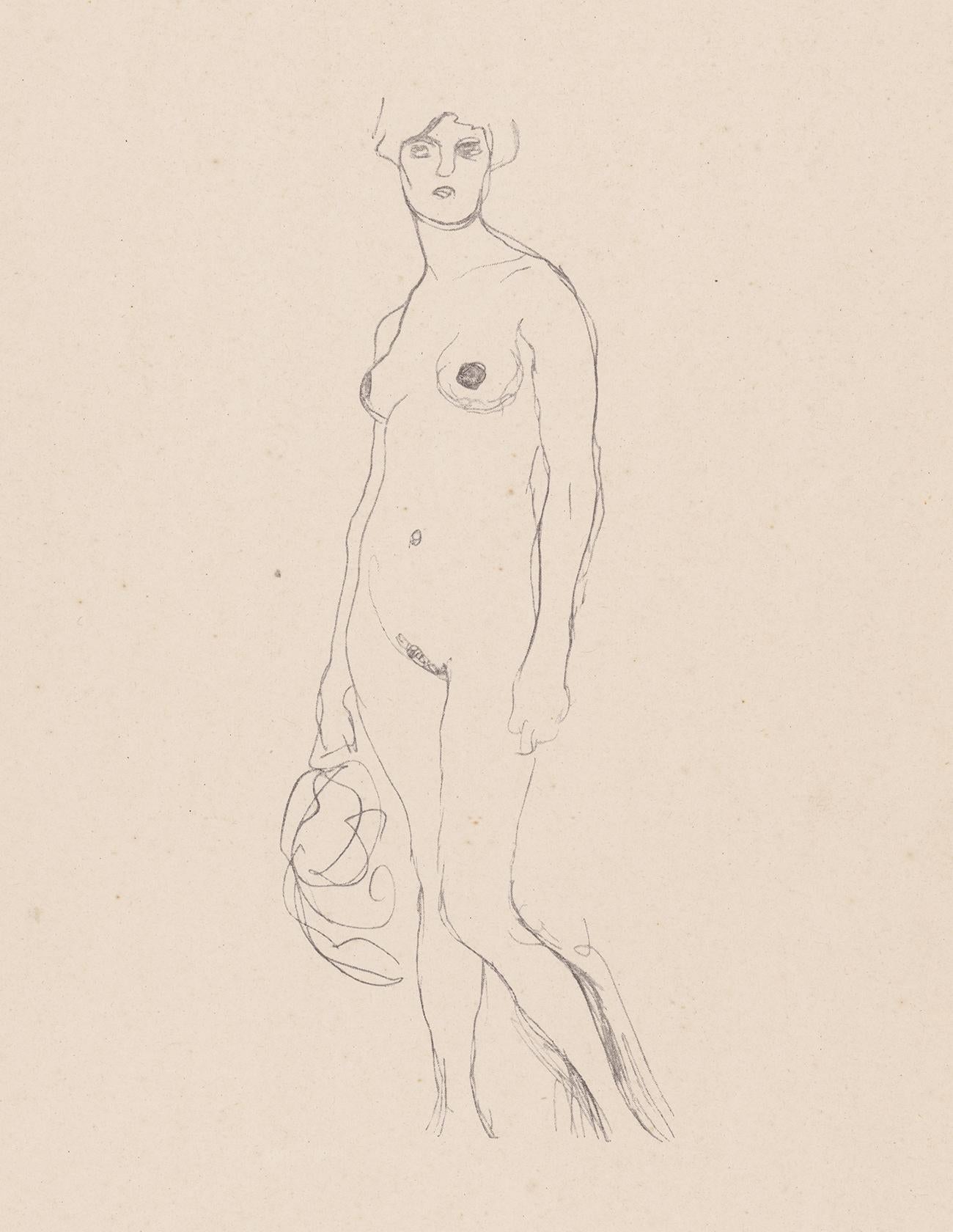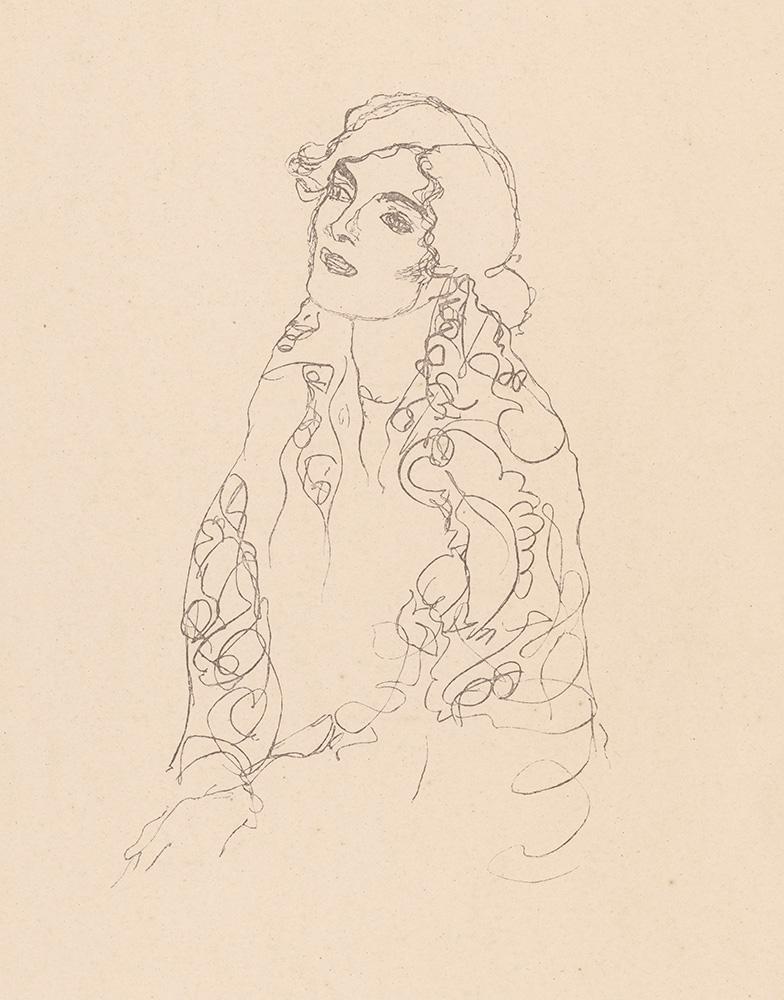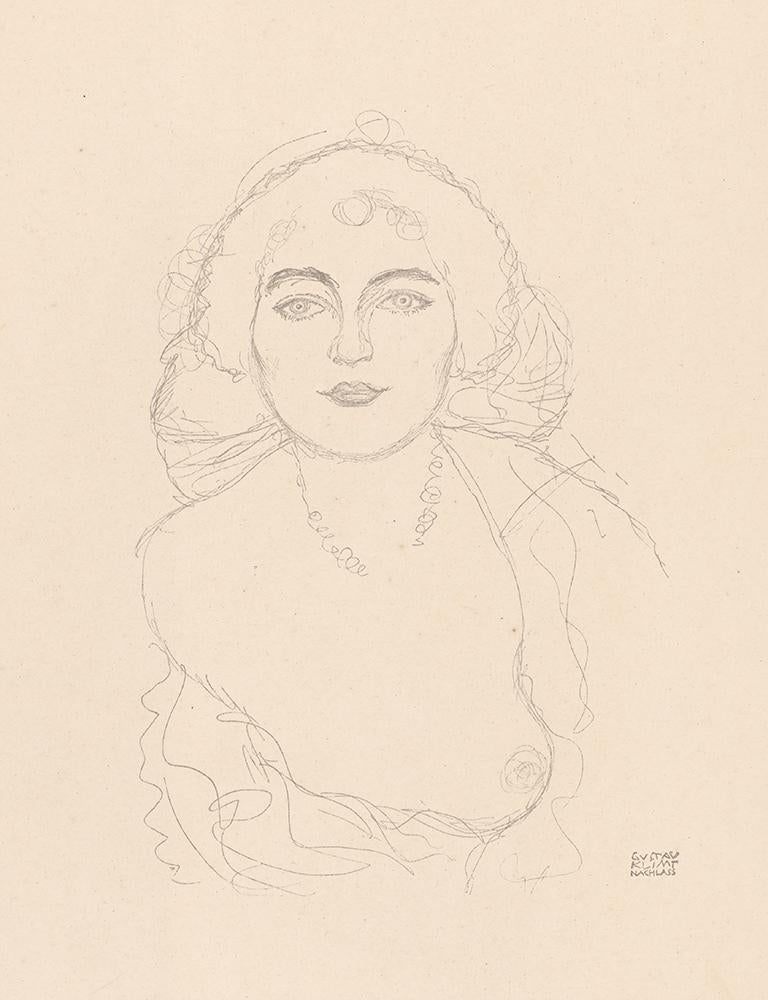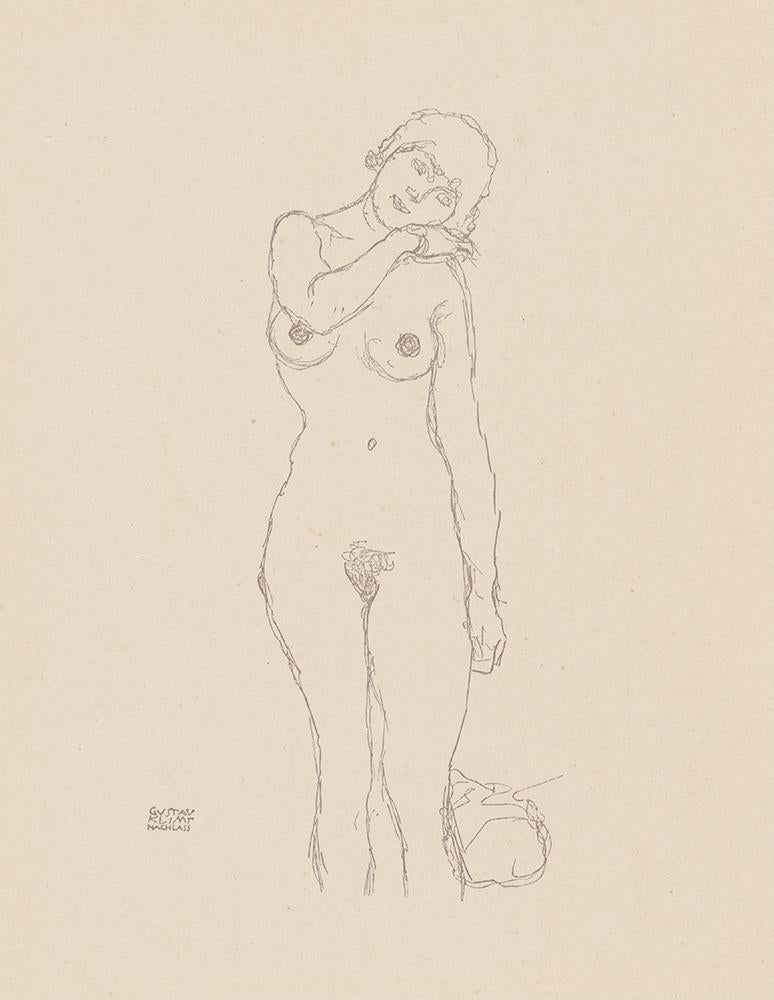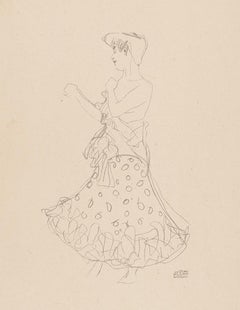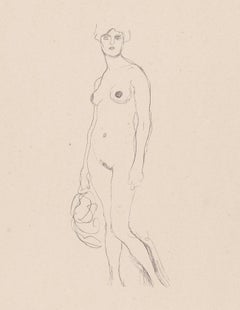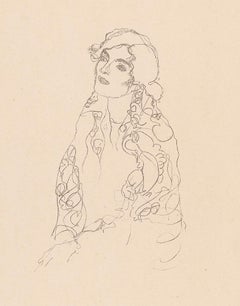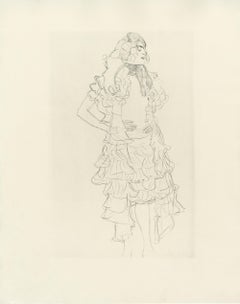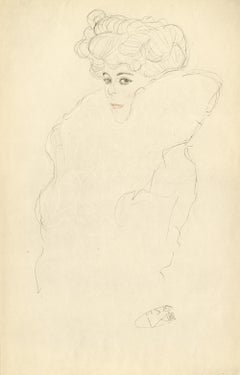Items Similar to Woman in dress, Gustav Klimt Handzeichnungen (Sketch), Thyrsos Verlag, 1922
Want more images or videos?
Request additional images or videos from the seller
1 of 3
Woman in dress, Gustav Klimt Handzeichnungen (Sketch), Thyrsos Verlag, 19221922
1922
$2,400
£1,822.38
€2,084.02
CA$3,353.15
A$3,729.43
CHF 1,947.39
MX$45,383.23
NOK 24,871.19
SEK 23,324.79
DKK 15,553.87
Shipping
Retrieving quote...The 1stDibs Promise:
Authenticity Guarantee,
Money-Back Guarantee,
24-Hour Cancellation
About the Item
Original collotype lithograph of Gustav Kilmt’s Woman in dress, published in the 1922 Handzeichnungen portfolio by Thyrsos Verlag, Leipzig and Vienna, in an edition of 375. This artwork is presented in archival rag mat and arrives accompanied by a certificate of authenticity.
Klimt’s mastery of depth is most evident in the gentleness of his linework. Without the aid of shadow or the subtlety of values, the gestures of line allow the viewer a sense of a three-dimensional person or object. The meticulous lithographic process used to create Klimt’s Handzeichnungen portfolio ensures exceptionally crisp markings bearing a strong resemblance to the original sketches. This series showcases the quintessence behind Klimt’s signature visual style. This artwork arrives accompanied by a certificate of authenticity.
Century Guild has curated collections of Gustav Klimt’s printed works on paper for over twenty years. Please contact us directly if you’d like to learn more about this artwork.
- Creation Year:1922
- Dimensions:Height: 10.5 in (26.67 cm)Width: 7.88 in (20.02 cm)Depth: 0.2 in (5.08 mm)
- Medium:
- Movement & Style:
- After:(after) Gustav Klimt (1862 - 1918, Austrian)
- Period:
- Condition:
- Gallery Location:Chicago, IL
- Reference Number:1stDibs: LU149329127702
About the Seller
5.0
Vetted Professional Seller
Every seller passes strict standards for authenticity and reliability
Established in 1999
1stDibs seller since 2021
40 sales on 1stDibs
Typical response time: <1 hour
- ShippingRetrieving quote...Shipping from: Chicago, IL
- Return Policy
Authenticity Guarantee
In the unlikely event there’s an issue with an item’s authenticity, contact us within 1 year for a full refund. DetailsMoney-Back Guarantee
If your item is not as described, is damaged in transit, or does not arrive, contact us within 7 days for a full refund. Details24-Hour Cancellation
You have a 24-hour grace period in which to reconsider your purchase, with no questions asked.Vetted Professional Sellers
Our world-class sellers must adhere to strict standards for service and quality, maintaining the integrity of our listings.Price-Match Guarantee
If you find that a seller listed the same item for a lower price elsewhere, we’ll match it.Trusted Global Delivery
Our best-in-class carrier network provides specialized shipping options worldwide, including custom delivery.More From This Seller
View AllWoman undressing, Gustav Klimt Handzeichnungen (Sketch), Thyrsos Verlag, 1922
By (after) Gustav Klimt
Located in Chicago, IL
Original collotype lithograph of a woman undressing from Gustav Kilmt’s handzeichnungen (sketch) in 1922 by Thyrsos Verlag, Leipzig and Vienna, in an edition of 375.
Klimt’s mastery of depth is most evident in the gentleness of his linework. Without the aid of shadow or the subtlety of values, the gestures of line allow the viewer a sense of a three-dimensional person or object. The meticulous lithographic process used to create Klimt’s Handzeichnungen portfolio ensures exceptionally crisp markings bearing a strong resemblance to the original sketches. This series showcases the quintessence behind Klimt’s signature visual style. This artwork arrives accompanied by a certificate of authenticity.
Century Guild has curated collections of Gustav Klimt’s printed...
Category
1920s Vienna Secession Prints and Multiples
Materials
Paper, Lithograph
Standing nude, Gustav Klimt Handzeichnungen (Sketch), Thyrsos Verlag, 1922
By (after) Gustav Klimt
Located in Chicago, IL
Original collotype lithograph of a figure drawing from Gustav Kilmt’s handzeichnungen (sketch) in 1922 by Thyrsos Verlag, Leipzig and Vienna, in an edition of 375. This artwork is pr...
Category
1920s Vienna Secession Prints and Multiples
Materials
Paper, Lithograph
Seated woman with shawl, Gustav Klimt Handzeichnungen (Sketch), 1922
By (after) Gustav Klimt
Located in Chicago, IL
Original collotype lithograph of Gustav Kilmt’s Seated woman with shawl, published in the 1922 Handzeichnungen portfolio by Thyrsos Verlag, Leipzig and Vienna, in an edition of 375. This artwork is presented in archival rag mat and arrives accompanied by a certificate of authenticity.
Klimt’s mastery of depth is most evident in the gentleness of his linework. Without the aid of shadow or the subtlety of values, the gestures of line allow the viewer a sense of a three-dimensional person or object. The meticulous lithographic process used to create Klimt’s Handzeichnungen portfolio ensures exceptionally crisp markings bearing a strong resemblance to the original sketches. This series showcases the quintessence behind Klimt’s signature visual style. This artwork arrives accompanied by a certificate of authenticity.
Century Guild has curated collections of Gustav Klimt’s printed...
Category
1920s Vienna Secession Prints and Multiples
Materials
Paper, Lithograph
Bust of a Woman, Gustav Klimt Handzeichnungen (Sketch), Thyrsos Verlag, 1922
By (after) Gustav Klimt
Located in Chicago, IL
Original collotype lithograph of Gustav Kilmt’s Bust of a Woman, published in the 1922 Handzeichnungen portfolio by Thyrsos Verlag, Leipzig and Vienna, in an edition of 375. This art...
Category
1920s Vienna Secession Prints and Multiples
Materials
Paper, Lithograph
Standing nude, Gustav Klimt Handzeichnungen (Sketch), Thyrsos Verlag, 1922
By (after) Gustav Klimt
Located in Chicago, IL
Original collotype lithograph of a figure drawing from Gustav Kilmt’s handzeichnungen (sketch) in 1922 by Thyrsos Verlag, Leipzig and Vienna, in an edition of 375. This artwork is pr...
Category
1920s Vienna Secession Prints and Multiples
Materials
Paper, Lithograph
Woman in scarf, Gustav Klimt Handzeichnungen (Sketch), Thyrsos Verlag, 1922
By (after) Gustav Klimt
Located in Chicago, IL
Original collotype lithograph of a well-dressed woman wearing a scarf around her face, leaving only her eyes exposed. This work was pubished from Gustav Kilmt’s handzeichnungen (sket...
Category
1920s Vienna Secession Prints and Multiples
Materials
Paper, Lithograph
You May Also Like
"Woman w/Lace Garment" by Gustav Klimt - Original Print from Courtesans Folio
By Gustav Klimt
Located in Chicago, IL
Plate #6 from Gustav Klimt's 1907 "Dialogues of the Courtesans" portfolio, consisting of 15 collotypes on cream japon paper. The drawings in this folio are said to be studies for Klimt's well-known Water Serpents paintings...
Category
Early 1900s Vienna Secession Figurative Prints
Materials
Paper
Gustav Klimt "Study for Woman in Boa" collotype from Funfundzwanzig folio
By Gustav Klimt
Located in Chicago, IL
Title page numbered: 263/450
Category
1910s Vienna Secession Figurative Prints
Materials
Paper
Gustav Klimt "Woman in Boa" collotype from Funfundzwanzig Handzeichnungen
By Gustav Klimt
Located in Chicago, IL
Title page numbered: 263/450. Includes handmade, gold-leaf frame.
Category
1910s Vienna Secession Figurative Prints
Materials
Paper
"Woman Leaning Forward" by Gustav Klimt - Original Print from Courtesans Folio
By Gustav Klimt
Located in Chicago, IL
Plate #3 from Gustav Klimt's 1907 "Dialogues of the Courtesans" portfolio, consisting of 15 collotypes on cream japon paper. The drawings in this folio are said to be studies for Klimt's well-known Water Serpents paintings...
Category
Early 1900s Vienna Secession Figurative Prints
Materials
Paper
Gustav Klimt "Standing Girl w/Lace Headdress" collotype - Funfundzwanzig folio
By Gustav Klimt
Located in Chicago, IL
Title page numbered: 263/450
Category
1910s Vienna Secession Figurative Prints
Materials
Paper
Sketched Portrait - 1910s - Original Collotype Print by Gustav Klimt
By (after) Gustav Klimt
Located in Roma, IT
Sketched Portrait is a vintage, beautiful, and rare collotype from “Gustav Klimt: Fünfundzwanzig Handzeichnungen”, a limited-edition collection of 25 monochrome and two-color collotypes after drawings by Gustav Klimt.
Published by Gilhofer and Ranschburg, Vienna, July 1919, just one year after Klimt...
Category
1910s Modern Portrait Prints
Materials
Black and White
More Ways To Browse
Klimt Dress
Poster Vintage Suisse
Raimondi Giuseppe
Tiffany Etching
Turkey Poster
Vintage Sunflower Prints
Christo Fabric
Clown Vintage Poster
George H W Bush
Georges Rouault Aquatint
Goya Engraving
Kaws Bearbrick
Keith Haring Baby
Picasso Dove Lithograph
Picasso Fleurs
Picasso Paysage
Retro Donald Art Company
Salvador Dali Original Oil
